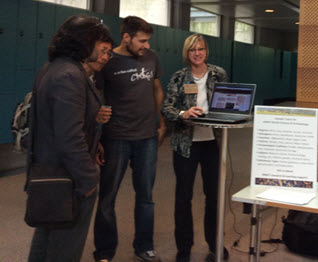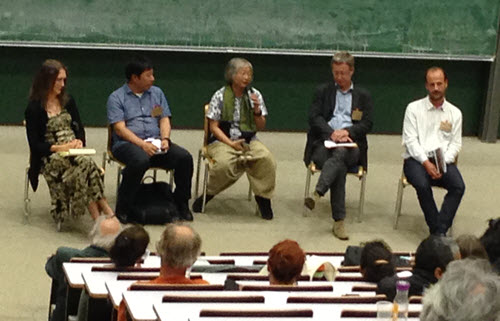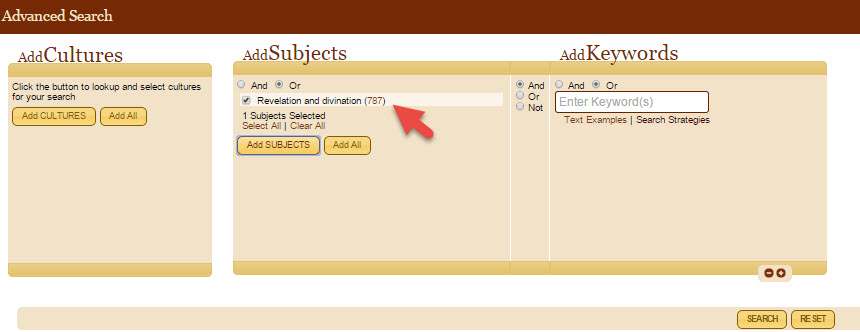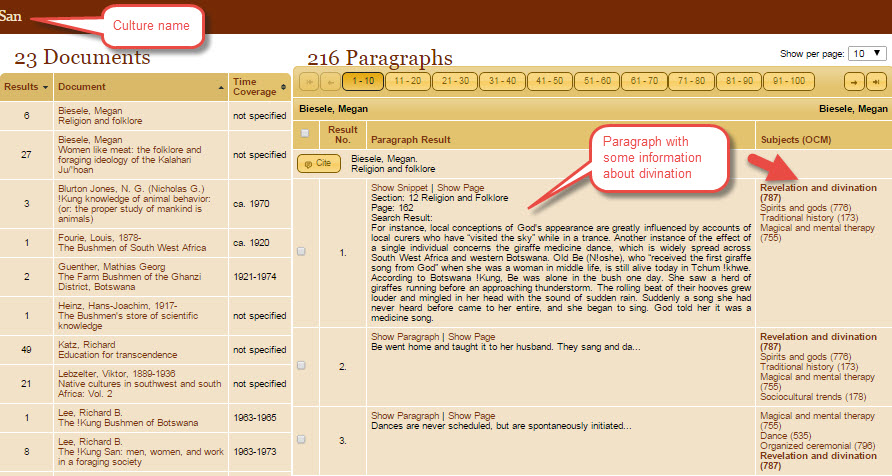
A welcome sign a the Eleventh Conference on Hunting and Gathering Societies. The CHAGS conference took place at the University of Vienna campus during the first week of September 2015. Photo credit: Christiane Cunnar
Earlier this month (September 7-11, 2015), the Eleventh Conference on Hunting and Gathering Societies (CHAGS XI) convened in Vienna, Austria. The conference was a joint effort of four major anthropological institutions in Vienna: the World Museum Vienna , the Institute for Social Anthropology of the Austrian Academy of Sciences, the Department of Social and Cultural Anthropology at the University of Vienna.
Christiane Cunnar, HRAF Member Services Administrator, attended the event and has the following reflections on the experience to share with us:
Khaled Hakami, one of the CHAGS organizers, had used the eHRAF World Cultures database before for his research and therefore knew that it had components useful for hunter-gatherer studies. He emailed an invitation to HRAF and we thought that attending would be a good idea for outreach to researchers from both member and non-member institutions.
Compared to the anthropology (AAA) and archaeological (SAA) conferences that HRAF usually attends, CHAGS is smaller and more focused with attention on contemporary hunter-gatherer issues.

HRAF representative Christiane Cunnar showing CHAGS conference attendees how to find information on hunter-gatherer societies in the eHRAF World Cultures database. Photo credit: Debora Zurro
HRAF’s information table was located in the refreshment area where conference attendees mingled during their breaks. In the opening speech, the keynote speaker had mentioned Human Relations Area Files, which generated quite lot of curiosity among attendees. They stopped by the table to learn more about HRAF and the eHRAF databases, picked up hand-outs, or presented me with specific research questions that they hoped to answer with eHRAF.
In addition to interactions at our table, the conference provided an excellent opportunity for me to attend papers and panel discussions to learn more about hunter-gatherer issues, always keeping in mind eHRAF’s functionality as research tool.
The talks and papers I attended were truly fascinating and covered a variety of topics such as indigenous legal practices, religious beliefs, practices defining small-scale societies, and women’s roles in contemporary hunting and gathering societies. One of the plenary sessions, “Hunter-gatherer Research, Human Evolution, and Human Nature: Dialogues and Debates” focused on varying viewpoints about the use of archaeological, biological, and ethnographic data on hunter-gatherers for explaining contemporary human behavior and human evolution.

Attendees after a session at the 11th CHAGS conference at the University of Vienna. Photo credit: Christiane Cunnar
One of the sessions that caught my interest was “Hunter-Gatherer Childhood” to see how it tied into our recent publication “Children’s Play and Work: The Relevance of Cross-Cultural Ethnographic Research for Archaeologists,” published in the September 2015 edition of the international journal “Childhood in the Past.”
At the CHAGS XI sessions, paper titles such as “Weaning practices among the Philippine Agta” and “Foraging, energetics, and play among the Hadza children” sounded quite interesting. From one of the talks, I learned that child-rearing is quite the communal activity that can involve up to 16 persons (relatives and non-relatives) to provide support for a mother in a hunter-gatherer society. I thought about the child-rearing support system (or lack of) for a mother in a western society, who may also have a full-time job. I am sure that comparisons already exist.
I found it interesting that there were two sessions in reference to human and animal relationships, including one specifically human-bird relationships of hunter-gatherer societies. CHAGS Titles included “Cree Goose Hunting and Ecological Calamity at James Bay,” “A bird motive in the culture of northern Mansi” and “Bird divination among the Eastern Penan, Sarawak, Malaysian Borneo: amen juhit.”

The final session on September 11th at the CHAGS XI was titled “What have we learnt.” Discussants included Lye Tuck-Po of Universiti Sains Malaysia, Penang (shown in the middle), Akira Takada of Kyoto University (to her left), Thomas Widlok of Cologne University (to her right), Jerome Lewis of University College of London (to the far right). Photo Credit: Christiane Cunnar
The concluding thoughts in the ending plenary session was a reaffirmation of the essence of what HRAF and eHRAF is about – geographic and interdisciplinary diversity. The eHRAF World Cultures and eHRAF Archaeology databases are one of the few academic online resources that allows researcher to contrast and compare the worlds’ major cultures across regions systematically and effectively. In terms of interdisciplinary efforts, HRAF aims to develop and apply new paradigms for comparative research to address outcomes emerging from human complexity and diversity. At Yale, HRAF launched its Advanced Research Center in 2014 with a project supported by the National Science Foundation. “Climate-Related Hazards, Disasters, and Cultural Transformations” has investigators from cultural anthropology, archaeology, psychology, geography and climatology, comparing worldwide samples of societies, archaeological traditions, and countries in their responses to hazards related to food production, storage, and availability.
Identifying Hunter-Gatherer Societies in eHRAF World Cultures & Archaeology
Those who have used the eHRAF World Cultures and eHRAF Archaeology databases know that HRAF’s online databases are unique in their organization and search functions including the following three aspects:
1. The collected documents (e.g. books, journal articles, dissertations, etc.) are organized by prehistoric and contemporary culture names (based on the Outline of World Cultures thesaurus), regions and sub-regions.
2. Culture names are identified by subsistence (e.g. hunter-gatherers) and sample types in the results menu after search terms are submitted.
3. Documents contain metadata such as dates for fieldwork, and time/place coverage and the texts (page and paragraph-levels) are indexed according to HRAF-specific subjects based on the Outline of Cultural Materials (OCM) thesaurus.
The following screenshots illustrate where these components are found in the process of searching eHRAF. For example, a search on the theme of divination, practiced by hunter-gatherer societies around the world, in the eHRAF World Cultures database using Advanced Search, might look like this:

eHRAF Advanced Search with “Revelation and divination,” selected as subject. All searchable subjects are based on the Outline of Cultural Materials (OCM) thesaurus. One or more subjects can be added to the search using the “Add SUBJECTS” button.
The next screenshot (below) shows the results after the above Advanced Search has been executed. In the results menu, the search can be refined to display only certain subsistence and sample types, or cultures from specific geographic locations.

In the eHRAF databases the cultures are identified as subsistence (and sample) types in the “Region and Culture Results” page, which appears AFTER a search is performed
Once the search results have been refined, the next step is to view the results that have been organized by region and culture name by selecting the culture names of interest. The final screenshot shows how the information about divination in the San hunter-gatherer culture is displayed in the texts of documents. Users have options to see snippets of text at the paragraph level or jump to the relevant full page. Note that the OCM codes for the subject entered – in this case, revelation and divination – will be visible on the right side of the page along with other OCMs that apply to the selected paragraphs.

Paragraph results for OCM subject “Revelation and divination” in ethnographic documents collected on the San culture
If you think that the eHRAF databases may be useful for your research, it’s best to contact me (Christiane Cunnar) at hraf@yale.edu to set up a trial. For more information about eHRAF and HRAF, as a non-profit organization visit https://hraf.yale.edu.